[vc_row type=”in_container” full_screen_row_position=”middle” scene_position=”center” text_color=”dark” text_align=”left” overlay_strength=”0.3″][vc_column column_padding=”no-extra-padding” column_padding_position=”all” background_color_opacity=”1″ background_hover_color_opacity=”1″ column_shadow=”none” width=”1/1″ tablet_text_alignment=”default” phone_text_alignment=”default” column_border_width=”none” column_border_style=”solid”][toggles style=”default” accordion=”true”][toggle color=”Extra-Color-3″ title=”Preventative Care”][vc_column_text]
Here are a few simple ways that you can prevent the build-up of plaque and cavities:
- Brush your teeth at least twice a day with a soft-bristled toothbrush. Use fluoride toothpaste to remove food particles and plaque from the tooth surfaces. Also be sure to brush the top surface of your tongue; this will remove any extra plaque-causing food particles, and help keep your breath fresh!
- Clean between your teeth by flossing at least once a day. You can also use a mouthwash to help kill bacteria and freshen your breath. Decay-causing bacteria can linger between teeth where toothbrush bristles can’t reach. Floss and mouthwash will help remove plaque and food particles from between the teeth and under the gum line.
Brushing Instructions
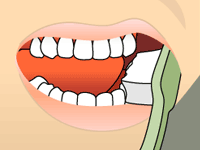
Brushing: Step 1
Place your toothbrush at a 45-degree angle to your gum.
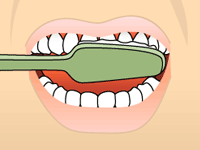
Brushing: Step 2
Brush gently in a circular motion.
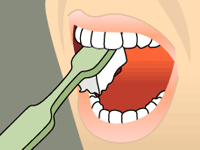
Brushing: Step 3
Brush the outer, inner, and chewing surfaces of each tooth.
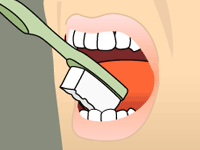
Brushing: Step 4
Use the tip of your brush for the inner surface of your front teeth.
Flossing Instructions
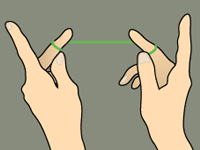
Flossing: Step 1
Wind about 18 inches of floss around your fingers as shown. Most of it should be wrapped around one finger, and as the floss is used, the other finger takes it up.
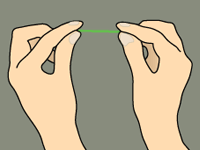
Flossing: Step 2
Use your thumbs and forefingers to guide about one inch of floss between your teeth.
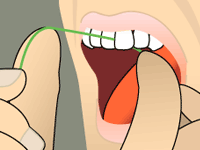
Flossing: Step 3
Holding the floss tightly, gently saw it between your teeth. Then curve the floss into a C-shape against one tooth and gently slide it beneath your gums.
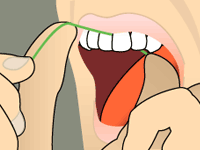
[/vc_column_text][/toggle][toggle color=”Extra-Color-3″ title=”Flouride”][vc_column_text]Fluoride is effective in preventing cavities and tooth decay and in preventing plaque from building up and hardening on the tooth’s surface. A fluoride treatment in your dentist’s office takes just a few minutes. After the treatment, patients may be asked not to rinse, eat, or drink for at least 30 minutes in order to allow the teeth to absorb the fluoride. Depending on your oral health or your doctor’s recommendation, you may be required to have a fluoride treatment every three, six, or 12 months.[/vc_column_text][/toggle][toggle color=”Extra-Color-3″ title=”VELscope”][vc_column_text]The VELscope® Vx Enhanced Oral Assessment System centers on a wireless, handheld scope that uses natural tissue fluorescence visualization to help clinicians see oral mucosal abnormalities that might otherwise have been overlooked.
Cleared by the FDA, and approved by Health Canada, and the World Health Organization, the award-winning VELscope® Vx is the world’s most widely used adjunctive device for the visualization of:
- Viral, fungal and bacterial infections;
- Inflammation from a variety of causes (lichen planus and lichenoid reactions, allergy to amalgam fillings, etc.);
- Squamous papillomas;
- Salivary gland tumors;
- Cancer and pre-cancer;
- Other oral mucosal conditions…
[/vc_column_text][/toggle][/toggles][/vc_column][/vc_row]